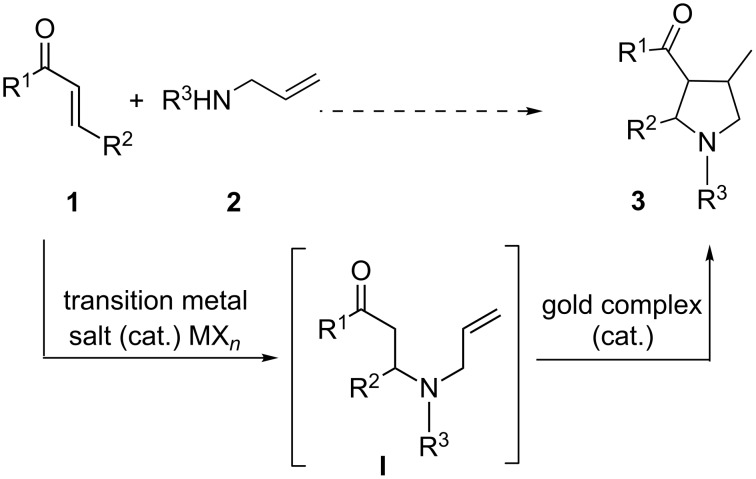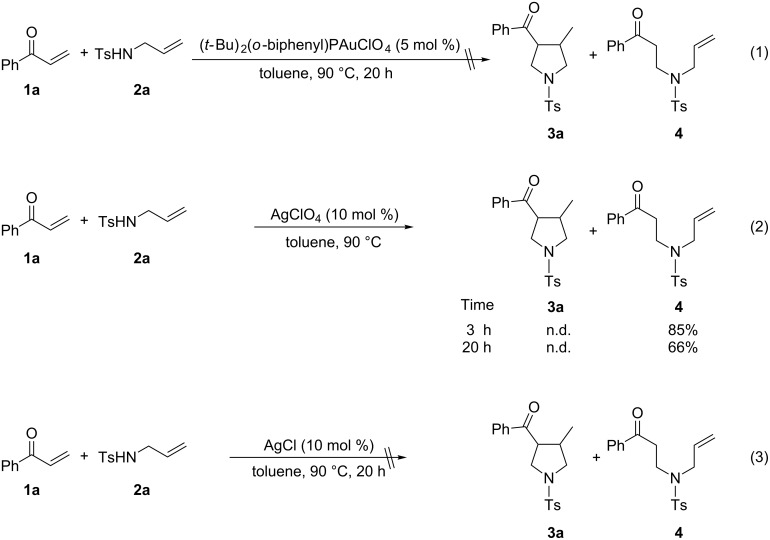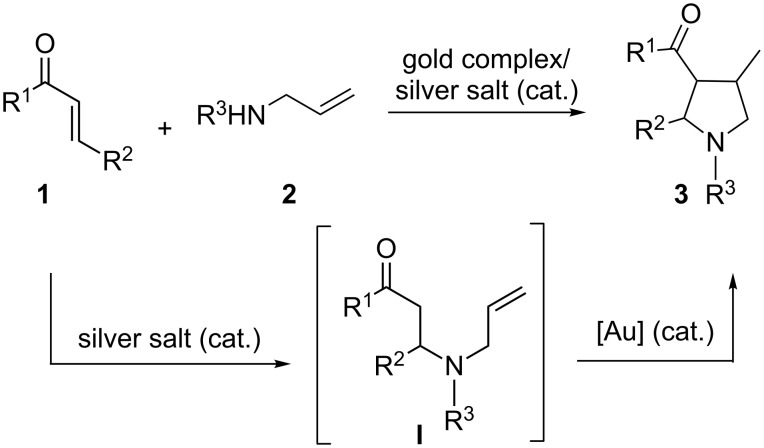Abstract
The gold(I)/silver(I)-cocatalyzed cascade intermolecular N-Michael addition/intramolecular hydroalkylation reaction offers a simple and efficient method for the synthesis of pyrrolidine derivatives in moderate to excellent product yields and with moderate to good diastereoselectivities. The reaction conditions and the substrate scope of this reaction are examined, and a possible mechanism involving AgClO4 catalyzed intermolecular N-Michael addition and the subsequent gold(I)-catalyzed hydroalkylation is proposed.
Keywords: cascade, cocatalyzed, gold(I)-catalyzed, intramolecular hydroalkylation, intermolecular N-Michael addition, pyrrolidine, silver(I)-catalyzed
Introduction
Gold complexes are presently receiving a surge of interest in the field of metal-catalyzed organic reactions. They have been shown to be versatile and efficient catalysts for the promotion of a large number of organic transformations, most of which are based on the propensity of gold ion to act as a soft and carbophilic Lewis acid to activate unsaturated C–C bonds towards nucleophilic attack [1–10] (for selected reviews on gold-catalyzed reactions see [1–9]). Based on this mode of activation, several methods for the gold-catalyzed inter- and intramolecular addition of oxygen- [11–15], nitrogen- [10,16–18] (for recent reviews on gold-catalyzed hydroamination see [16–18]), or carbon-nucleophiles [19–24] to unactivated alkenes [21–25] have been developed. On the other hand, in recent years, considerable efforts have been devoted to the development of dual-metal-catalyzed reactions as new strategies for the synthesis of organic compounds with intriguing diversity and selectivity [26–29] (for reviews on cooperative catalysis see [26–27] and for a general review on cocatalysis see [28]). This type of reaction could have the advantages of the combined characteristic features of two metals, often displaying unique reactivity, have a shortened synthetic route and generate less chemical waste. All of these features are of significant economic and environmental benefit. In this context, extensive studies have been conducted on the design and utilization of dual-metal catalyst systems in organic synthesis [26–40] (for recent examples of Au/Pd-cocatalysis see [30–33]; for Au/Mo-cocatalysis see [31,35]; for Au/Ag-cocatalysis see [36–38]; for Au/Yb-cocatalysis see [39] and for Au/Rh-cocatalysis see [40]). However, the use of homogeneous gold catalysts in cooperation with other metal catalysts has been reported only in a few cases [30–40]. In this work, we describe a highly efficient gold(I)/silver(I)-cocatalyzed cascade intermolecular N-Michael addition/intramolecular hydroalkylation process. A variety of pyrrolidine compounds were conveniently prepared in moderate to excellent yields and with moderate to good diastereoselectivities from the simple starting materials.
More recently, we have reported that gold(I) complexes can efficiently catalyze direct intramolecular hydroalkylation of unactivated alkenes with α-ketones, via the exo-trig cyclization, to build a variety of new five- and six-membered rings [24]. However, all of the substrates examined in this gold(I)-catalyzed reaction were prepared and isolated prior to use, and this is not desirable as the synthesis of these substrates could be tedious and time-consuming. The increasing demand for environmentally benign and economical synthetic processes calls for the development of cascade reactions for the efficient construction of cyclic compounds from simple starting materials [41]. We initially envisioned that the gold(I)-catalyzed cascade process could be established starting from the intermolecular N-Michael reaction of α,β-unsaturated ketone 1 and substituted allylamine 2 to furnish an α-ketone intermediate I [42–44] (for gold-catalyzed intramolecular N-Michael reaction see [42–43]), which further undergoes a subsequent gold(I)-catalyzed hydroalkylation to give pyrrolidine compounds 3 (Scheme 1); these compounds are versatile synthetic building blocks for organic synthesis and are important structural elements of many therapeutic drug molecules. Disappointingly, no conversion was observed when (t-Bu)2(o-diphenyl)PAuOTf only was used as the catalyst. Since dual-metal-catalysis is of interest from the perspective of unique reactivity [26–40], we explored a new cascade reaction involving intermolecular N-Michael addition catalyzed by an appropriate transition metal salt and subsequent intramolecular hydroalkylation catalyzed by a gold complex (Scheme 1).
Scheme 1.
Cascade intermolecular N-Michael addition/intramolecular hydroalkylation of unactivated alkenes with α-ketones catalyzed by a dual-metal catalytic system comprising a transition metal salt and a gold(I) complex.
Results and Discussion
The optimization of the reaction conditions was performed using the reaction of phenyl vinyl ketone (1a) with N-tosylallylamine (2a) in the presence of 5 mol % of (t-Bu)2(o-diphenyl)PAuOTf. However, no desired product 3a was observed (Table 1, entry 1). When using a combination of 5 mol % of (t-Bu)2(o-diphenyl)PAuCl and AgOTf as catalyst, the corresponding product 3a was obtained in 25% yield (Table 1, entry 2) (a small amount of silver salt may have remained in the reaction system when the mol ratio of silver salt to gold complex was 1:1, see [45]). Upon further increase of the AgOTf loading to 10 mol %, the corresponding product 3a was formed in 58% yield with a diastereomeric ratio of 5.4:1 (Table 1, entry 3) [46]. Using a combination of 5 mol % of (t-Bu)2(o-diphenyl)PAuCl and 15 mol % of AgOTf as a dual-metal catalyst system lead to the formation of pyrrolidine derivative 3a as a 5.3:1 mixture of two diastereomers in 67% yield (Table 1, entry 4). The yield increased from 58% to 67% as the mol ratio of 2a to 1a was increased from 1.2/1 to 1.5/1 (Table 1, entries 4 and 5). However, the yield did not increase remarkably when the mol ratio of 2a to 1a was raised from 1.5/1 to 2.5/1 (Table 1, entries 4–7). As depicted in Table 1, varying the method of the addition of phenyl vinyl ketone (1a) to the reaction mixture did not have a noticeable effect on the yield of 3a (Table 1, entries 8–11).
Table 1.
The optimization of the reaction conditions.
 | ||||
| entrya | x (mol %) | mol ratio (2a/1a) | trans/cisb | yield (%)b |
| 1c | 5 | 1.5/1 | – | –d |
| 2 | 5 | 1.5/1 | 1.4:1 | 25 |
| 3 | 10 | 1.5/1 | 5.4:1 | 58 |
| 4 | 15 | 1.5/1 | 5.3:1 | 67 |
| 5 | 15 | 1.2/1 | 5.7:1 | 58 |
| 6 | 15 | 2.0/1 | 5.9:1 | 66 |
| 7 | 15 | 2.5/1 | 5.5:1 | 64 |
| 8 | 15 | 1/1.5 | 5.5:1 | 64 |
| 9e | 15 | 1/1.5 | 5.2:1 | 60 |
| 10f | 15 | 1/1.5 | 5.5:1 | 65 |
| 11g | 15 | 1/1.5 | 5.5:1 | 64 |
aReactions were carried out in toluene (0.5 mL) at 0.25 mmol scale based on 1a or 2a, 1a was added in one portion. bYield and selectivity were determined by 1H NMR spectroscopy (internal standard: trimethyl(phenyl)silane). c5 mol % of (t-Bu)2(o-diphenyl)PAuOTf was used as catalyst. dno desired product 3a was detected. e1a (dissolved in 0.3 mL of toluene) was added dropwise over 6 h. f1a was added in two portions every 3 h. g1a was added in three portions every 2 h.
To identify further the optimal reaction conditions for the gold(I)/silver(I)-cocatalyzed cascade reaction, a number of dual-metal catalyst systems, composed of 15 mol % of silver salt with 5 mol % of gold(I) complex in different organic solvents, were tested in the reaction of phenyl vinyl ketone (1a) with 1.5 equiv of N-tosylallylamine (2a) (Table 2). AgClO4 was found to be the best silver salt for this reaction (Table 2, entries 1–5). A panel of Au(I) complexes with different ancillary ligands was also screened for activity and diastereo-induction in this cascade reaction (Table 2, entries 5–9). Among the complexes examined, (t-Bu)2(o-biphenyl)PAuCl gave the best result (Table 2, entry 5). Further screening of solvents revealed that toluene gave the best result, while the other solvents, dioxane, nitromethane, 1,2-dichloroethane, tetrahydrofuran, benzene, and acetonitrile, gave low product yields and low diastereoselectivity (Table 2, entries 5 and 10–15). After optimization of the reaction conditions, the protocol with the combination of 5 mol % of (t-Bu)2(o-biphenyl)PAuCl and 15 mol % of AgClO4 as a dual-metal catalyst system at 90 °C in toluene for 20 h gave the product 3a in 76% yield.
Table 2.
Screening catalysts and solvents.
 | ||||
| entrya | gold catalyst/silver salt | solvent | trans/cisb | yield (%)b |
| 1 | (t-Bu)2(o-biphenyl)PAuCl/AgOTf | toluene | 5.3:1 | 67 |
| 2 | (t-Bu)2(o-biphenyl)PAuCl/AgSbF6 | toluene | 2.2:1 | 35 |
| 3 | (t-Bu)2(o-biphenyl)PAuCl/AgPF6 | toluene | 2.6:1 | 62 |
| 4 | (t-Bu)2(o-biphenyl)PAuCl /AgBF4 | toluene | – | <5 |
| 5 | (t-Bu)2(o-biphenyl)PAuCl/AgClO4 | toluene | 4.1:1 | 76 |
| 6 | Ph3PAuCl/AgClO4 | toluene | – | <5 |
| 7 | Cy3PAuCl/AgClO4 | toluene | – | <5 |
| 8 | IPrAuCl/AgClO4c | toluene | 4.4:1 | 63 |
| 9 | L1AuCl/AgClO4d | toluene | 3.1:1 | 50 |
| 10 | (t-Bu)2(o-biphenyl)PAuCl/AgClO4 | dioxane | 4.0:1 | 63 |
| 11 | (t-Bu)2(o-biphenyl)PAuCl/AgClO4 | CH3NO2 | 2.8:1 | 47 |
| 12e | (t-Bu)2(o-biphenyl)PAuCl/AgClO4 | DCE | 1.8:1 | 34 |
| 13e | (t-Bu)2(o-biphenyl)PAuCl/AgClO4 | THF | 1.8:1 | 76 |
| 14e | (t-Bu)2(o-biphenyl)PAuCl/AgClO4 | benzene | 3.2:1 | 60 |
| 15e | (t-Bu)2(o-biphenyl)PAuCl/AgClO4 | CH3CN | – | <5 |
aReactions were carried out in toluene (0.5 mL) at 0.25 mmol scale, 1a (0.25 mmol) and 2a (0.375 mmol) were added in one portion. bYield and selectivity were determined by 1H NMR spectroscopy (internal standard: trimethyl(phenyl)silane). cIPr= N,N’-bis(2,6-diisopropylphenyl)imidazol-2-ylidene. dL1 = (Cy)2(2',4',6'-triisopropyl-o-biphenyl)P. eReactions were carried out under reflux.
With the optimal reaction conditions, we next explored the substrate scope with the protocol for the Au(I)/Ag(I)-cocatalytic system (Table 3). For example, treatment of substrate 1b, which has an electron-donating para-methoxy group on the phenyl ring, with 2a under the optimized reaction conditions gave the expected product 3b in 92% yield, albeit with no diastereoselectivity (Table 3, entry 2). In addition to substrate 1b, α,β-unsaturated ketone 1c, with electron-withdrawing substituent on the phenyl ring, underwent this cascade reaction to afford the corresponding product 3c in 58% yield with a diastereomeric ratio of 1.7:1 (Table 3, entry 3). Reaction of alkyl α,β-unsaturated ketone 1d in the presence of 5 mol % of (t-Bu)2(o-biphenyl)PAuCl and 15 mol % of AgClO4 also gave the desired product 3d in 92% yield with a diastereomeric ratio of 5.5:1 (Table 3, entry 4). Other substituted allylamines were also examined. A series of substituted allylamines with 4-nitrobenzenesulfonyl group and 2,4,6-triisopropylbenzenesulfonyl group were similarly treated with alkyl α,β-unsaturated ketone 1d, and the corresponding products 3e and 3f were obtained in moderate to excellent yields with similar diastereomeric ratios of around 5.2:1 (Table 3, entries 4–6). Notably, the gold(I)/silver(I)-cocatalyzed cascade reaction was also successfully applied to furnish spirocyclic pyrrolidine derivative 3g in 52% yield starting from the readily available precursor 2-methylene-3,4-dihydronaphthalen-1(2H)-one (1e) and N-tosylallylamine (2a) (Table 3, entry 7).
Table 3.
Cascade synthesis of pyrrolidine catalyzed by a dual-metal catalytic system comprising of gold(I) and silver(I) catalysts.
 | |||||
| entrya | α,β-unsaturated ketone | substituted allylamine | major product | drb | yield (%)b |
| 1 |  |
 |
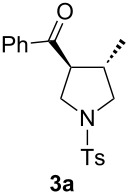 |
4.1:1 | 76 |
| 2 | 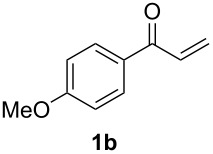 |
 |
 |
1.0:1 | 92 |
| 3 | 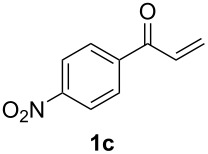 |
 |
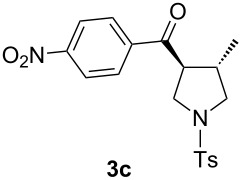 |
1.7:1 | 58 |
| 4 |  |
 |
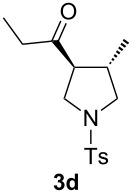 |
5.5:1 | 92 |
| 5 |  |
 |
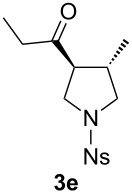 |
5.3:1 | 76 |
| 6c |  |
 |
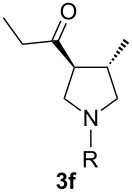 |
5.2:1 | 91 |
| 7 | 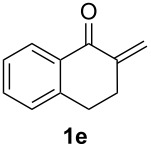 |
 |
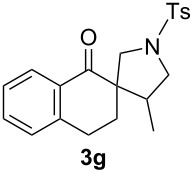 |
1.8:1 | 52 |
aReactions were carried out in toluene (0.5 mL) at 0.25 mmol scale. The α,β-unsaturated ketone (0.25 mmol) and the substituted allyl amine (0.375 mmol) were added in one portion. bYield and selectivity were determined by 1H NMR spectroscopy (internal standard: trimethyl(phenyl)silane). cR = 2,4,6-triisopropylbenzenesulfonyl.
To gain insight into the mechanism of the gold(I)/silver(I)-cocatalyzed cascade reaction, we first examined the reaction of phenyl vinyl ketone (1a) with 1.5 equiv of N-tosylallylamine (2a) in the presence of 5 mol % of (t-Bu)2(o-biphenyl)PAuClO4 at 90 °C in toluene for 20 h, however, no desired product 3a or α-ketone intermediate 4 was observed by 1H NMR analysis of the reaction mixture (Scheme 2, reaction 1). This finding revealed that the gold(I) complex is ineffective in the catalysis of the intermolecular N-Michael reaction. Upon subsequent treatment of phenyl vinyl ketone (1a) with N-tosylallylamine (2a) in the presence of 10 mol % of AgClO4 at 90 °C for 3 h, the α-ketone intermediate 4 was formed in 85% yield, however, no product 3a was observed. Even after a longer reaction time (20 h) under the same reaction conditions, 3a was also not detected, and α-ketone intermediate 4 was isolated in lower yield (66%) (Scheme 2, reaction 2), which may be due to the retro-N-Michael reaction [47]. On the other hand, product 3a and α-ketone intermediate 4 were not observed in the presence of 10 mol % of AgCl under the same reaction conditions (Scheme 2, reaction 3), revealing that the newly formed AgCl from the reaction of (t-Bu)2(o-biphenyl)PAuCl and AgClO4 did not affect the reaction. All the results demonstrated the dual roles of the silver salt that serves firstly to abstract the coordinated Cl− ligand, to give a reactive gold catalyst, and secondly to act as an efficient catalyst for the intermolecular N-Michael addition.
Scheme 2.
Some control experiments.
On the basis of these observations and our previous work on gold(I)-catalyzed intramolecular hydroalkylation of unactivated alkenes with α-ketones [24], a reaction mechanism for the formation of pyrrolidine 3 from the reaction of α,β-unsaturated ketone 1 with substituted allylamine 2 is proposed (Scheme 3), which involves silver-catalyzed intermolecular N-Michael addition of substituted allylamine 2 to α,β-unsaturated ketone 1 to generate the α-ketone intermediate I and subsequent gold(I)-catalyzed intramolecular hydroalkylation of the α-ketone intermediate I to form the cyclic compound 3 (Scheme 3).
Scheme 3.
The reaction pathway.
Conclusion
In summary, we have developed a simple and efficient gold(I)/silver(I)-cocatalyzed cascade intermolecular N-Michael addition/intramolecular hydroalkylation reaction. The present protocol with a dual-metal catalytic system provides a highly efficient method for the synthesis of a variety of pyrrolidine compounds in moderate to excellent product yields and with moderate to good diastereoselectivities from α,β-unsaturated ketones and substituted allylamines. Further studies to expand the substrate scope are currently in progress.
Supporting Information
Experimental section and spectra of compounds.
Acknowledgments
This work was supported by The University of Hong Kong (University Development Fund), the Hong Kong Research Grants Council, and the University Grants Committee of the Hong Kong SAR of China (Area of Excellence Scheme, AoE/P-10/01). Y.-P. Xiao thanks the Croucher Foundation of Hong Kong for a postgraduate studentship and the External Cooperation Program of CAS (GJHZ200816). We thank the referees for their insightful suggestions concerning this paper.
This article is part of the Thematic Series "Gold catalysis for organic synthesis".
Contributor Information
Ya-Ping Xiao, Email: xiaoyaping82@hotmail.com.
Xin-Yuan Liu, Email: liuxy@hku.hk.
Chi-Ming Che, Email: cmche@hku.hk.
References
- 1.Gorin D J, Toste F D. Nature. 2007;446:395–403. doi: 10.1038/nature05592. [DOI] [PubMed] [Google Scholar]
- 2.Hashmi A S K. Chem Rev. 2007;107:3180–3211. doi: 10.1021/cr000436x. [DOI] [PubMed] [Google Scholar]
- 3.Li Z, Brouwer C, He C. Chem Rev. 2008;108:3239–3265. doi: 10.1021/cr068434l. [DOI] [PubMed] [Google Scholar]
- 4.Jiménez-Núñez E, Echavarren A M. Chem Rev. 2008;108:3326–3350. doi: 10.1021/cr0684319. [DOI] [PubMed] [Google Scholar]
- 5.Gorin D J, Sherry B D, Toste F D. Chem Rev. 2008;108:3351–3378. doi: 10.1021/cr068430g. [DOI] [PMC free article] [PubMed] [Google Scholar]
- 6.Hashmi A S K. Angew Chem, Int Ed. 2010;49:5232–5241. doi: 10.1002/anie.200907078. [DOI] [PubMed] [Google Scholar]
- 7.Corma A, Leyva-Perez A, Sabater M J. Chem Rev. 2011;111:1657–1712. doi: 10.1021/cr100414u. [DOI] [PubMed] [Google Scholar]
- 8.Krause N, Winter C. Chem Rev. 2011;111:1994–2009. doi: 10.1021/cr1004088. [DOI] [PubMed] [Google Scholar]
- 9.Bandini M. Chem Soc Rev. 2011;40:1358–1367. doi: 10.1039/c0cs00041h. [DOI] [PubMed] [Google Scholar]
- 10.LaLonde R L, Brenzovich J W E, Benitez D, Tkatchouk E, Kelley K, Goddard W A, III, Toste F D. Chem Sci. 2010;1:226–233. doi: 10.1039/c0sc00255k. [DOI] [PMC free article] [PubMed] [Google Scholar]
- 11.Yang C-G, He C. J Am Chem Soc. 2005;127:6966–6967. doi: 10.1021/ja050392f. [DOI] [PubMed] [Google Scholar]
- 12.Nguyen R-V, Yao X, Li C-J. Org Lett. 2006;8:2397–2399. doi: 10.1021/ol0607692. [DOI] [PubMed] [Google Scholar]
- 13.Hashmi A S K, Schäfer S, Wölfle M, Diez Gil C, Fischer P, Laguna A, Blanco M C, Gimeno M C. Angew Chem, Int Ed. 2007;46:6184–6187. doi: 10.1002/anie.200701521. [DOI] [PubMed] [Google Scholar]
- 14.Zhang X, Corma A. Chem Commun. 2007:3080–3082. doi: 10.1039/b706961h. [DOI] [PubMed] [Google Scholar]
- 15.Aponick A, Li C-Y, Biannic B. Org Lett. 2008;10:669–671. doi: 10.1021/ol703002p. [DOI] [PubMed] [Google Scholar]
- 16.Widenhoefer R A, Han X. Eur J Org Chem. 2006:4555–4563. doi: 10.1002/ejoc.200600399. [DOI] [Google Scholar]
- 17.Widenhoefer R A. Chem–Eur J. 2008;14:5382–5391. doi: 10.1002/chem.200800219. [DOI] [PubMed] [Google Scholar]
- 18.Krause N, Belting V, Deutsch C, Erdsack J, Fan H T, Gockel B, Hoffmann-Röder A, Morita N, Volz F. Pure Appl Chem. 2008;80:1063–1069. doi: 10.1351/pac200880051063. [DOI] [Google Scholar]
- 19.Yao X, Li C-J. J Am Chem Soc. 2004;126:6884–6885. doi: 10.1021/ja0482637. [DOI] [PubMed] [Google Scholar]
- 20.Nguyen R-V, Yao X-Q, Bohle D S, Li C-J. Org Lett. 2005;7:673–675. doi: 10.1021/ol047543o. [DOI] [PubMed] [Google Scholar]
- 21.Zhou C-Y, Che C-M. J Am Chem Soc. 2007;129:5828–5829. doi: 10.1021/ja070027j. [DOI] [PubMed] [Google Scholar]
- 22.Wang M-Z, Wong M-K, Che C-M. Chem–Eur J. 2008;14:8353–8364. doi: 10.1002/chem.200800040. [DOI] [PubMed] [Google Scholar]
- 23.Xiao Y-P, Liu X-Y, Che C-M. J Organomet Chem. 2009;694:494–501. doi: 10.1016/j.jorganchem.2008.07.035. [DOI] [Google Scholar]
- 24.Xiao Y-P, Liu X-Y, Che C-M. Angew Chem, Int Ed. 2011;50:4937–4941. doi: 10.1002/anie.201100044. [DOI] [PubMed] [Google Scholar]
- 25.Liu X-Y, Li C-H, Che C-M. Org Lett. 2006;8:2707–2710. doi: 10.1021/ol060719x. [DOI] [PubMed] [Google Scholar]
- 26.Van den Beuken E K, Feringa B L. Tetrahedron. 1998;54:12985–13011. doi: 10.1016/S0040-4020(98)00319-6. [DOI] [Google Scholar]
- 27.Park Y J, Park J-W, Jun C-H. Acc Chem Res. 2008;41:222–234. doi: 10.1021/ar700133y. [DOI] [PubMed] [Google Scholar]
- 28.Lee J M, Na Y, Han H, Chang S. Chem Soc Rev. 2004;33:302–312. doi: 10.1039/b309033g. [DOI] [PubMed] [Google Scholar]
- 29.Wasilke J-C, Obrey S J, Baker R T, Bazan G C. Chem Rev. 2005;105:1001–1020. doi: 10.1021/cr020018n. [DOI] [PubMed] [Google Scholar]
- 30.Shi Y, Peterson S M, Haberaecker W W, III, Blum S A. J Am Chem Soc. 2008;130:2168–2169. doi: 10.1021/ja710648b. [DOI] [PubMed] [Google Scholar]
- 31.Shi Y, Ramgren S D, Blum S A. Organometallics. 2009;28:1275–1277. doi: 10.1021/om801206g. [DOI] [Google Scholar]
- 32.Hashmi A S K, Lothschütz C, Döpp R, Rudolph M, Ramamurthi T D, Rominger F. Angew Chem, Int Ed. 2009;48:8243–8246. doi: 10.1002/anie.200902942. [DOI] [PubMed] [Google Scholar]
- 33.Shi Y, Roth K E, Ramgren S D, Blum S A. J Am Chem Soc. 2009;131:18022–18023. doi: 10.1021/ja9068497. [DOI] [PubMed] [Google Scholar]
- 34.Egi M, Yamaguchi Y, Fujiwara N, Akai S. Org Lett. 2008;10:1867–1870. doi: 10.1021/ol800596c. [DOI] [PubMed] [Google Scholar]
- 35.Ye L, Zhang L. Org Lett. 2009;11:3646–3649. doi: 10.1021/ol901346k. [DOI] [PubMed] [Google Scholar]
- 36.Weber D, Tarselli M A, Gagné M R. Angew Chem, Int Ed. 2009;48:5733–5736. doi: 10.1002/anie.200902049. [DOI] [PMC free article] [PubMed] [Google Scholar]
- 37.Weber D, Gagne M R. Org Lett. 2009;11:4962–4965. doi: 10.1021/ol902116b. [DOI] [PMC free article] [PubMed] [Google Scholar]
- 38.Ramon R S, Bosson J, Diez-Gonzalez S, Marion N, Nolan S P. J Org Chem. 2010;75:1197–1202. doi: 10.1021/jo902461a. [DOI] [PubMed] [Google Scholar]
- 39.Dai L-Z, Shi M. Chem–Eur J. 2010;16:2496–2502. doi: 10.1002/chem.200902321. [DOI] [PubMed] [Google Scholar]
- 40.Aksın-Artok Ö, Krause N. Adv Synth Catal. 2011;353:385–391. doi: 10.1002/adsc.201000903. [DOI] [Google Scholar]
- 41.Tietze L F, Gordon B, Kersten G M, editors. Domino Reactions in Organic Synthesis. Weinheim, Germany: Wiley-VCH; 2006. [Google Scholar]
- 42.Jung H H, Floreancig P E. J Org Chem. 2007;72:7359–7366. doi: 10.1021/jo071225w. [DOI] [PubMed] [Google Scholar]
- 43.Huang J, Huang X, Liu B. Org Biomol Chem. 2010;8:2697–2699. doi: 10.1039/c003734f. [DOI] [PubMed] [Google Scholar]
- 44.Kobayashi S, Kakumoto K, Sugiura M. Org Lett. 2002;4:1319–1322. doi: 10.1021/ol0256163. [DOI] [PubMed] [Google Scholar]
- 45.Lin G-Y, Li C-W, Hung S-H, Liu R-S. Org Lett. 2008;10:5059–5062. doi: 10.1021/ol802047g. [DOI] [PubMed] [Google Scholar]
- 46.The control experiment was suggested by one reviewer. We used the product 3a with a diastereomeric ratio of 1.5:1 heated with 5 mol % of (t-Bu)2(o-diphenyl)PAuCl and 10 mol % of AgOTf in toluene at 90 °C, indeed, we could get a 5.2:1 mixture of two diastereomers after 20 h. The effect of catalyst loading on diastereoselectivity may be due to the silver salt acting as a lewis acid promoting the isomeration of cis-configuration to trans-configuration.
- 47.Gaunt M J, Spencer J B. Org Lett. 2001;3:25–28. doi: 10.1021/ol0066882. [DOI] [PubMed] [Google Scholar]
Associated Data
This section collects any data citations, data availability statements, or supplementary materials included in this article.
Supplementary Materials
Experimental section and spectra of compounds.



